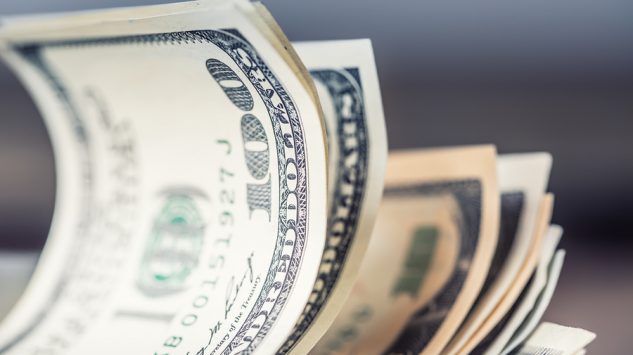Issue Briefs

Hollowed-Out Blue Chips Are The Next Subprime
By Martin Hutchinson
November 13, 2017
Subprime mortgages caused much of the 2008 financial crisis by defaulting in much greater concentrations than the experts expected. The next financial crisis is likely to be caused by a similar disaster that surprises the experts. I have an excellent candidate: Fortune 500 companies that have been repurchasing their shares like maniacs for a decade, and in many cases have left themselves with negative net worth. In a major recession, when their business drops off and their cash flow turns negative, they will only need a breath of adverse wind to default. Like the subprime mortgages, once a few major companies default, the rest, with fragile credit structures, will fall like dominoes.
Overpriced acquisitions and share repurchases
There are two mechanisms by which the balance sheets of major companies have been hollowed out: overpriced acquisitions and share repurchases. Both are products of a decade of interest rates held far below their natural level, which have abominably skewed the economy’s allocation of resources.
In the case of overpriced acquisitions, even companies that make a low return appear attractive purchases if you can borrow at a negative real cost to finance their acquisition. Share repurchases meanwhile are more attractive than dividends because they goose the value of management’s stock options. If long term money can be borrowed at 3% on a tax-deductible basis, then it makes sense to go on buying the company’s shares up to 33 times earnings, even if there is no earnings growth to be had.
Bad acquisitions
The effect on balance sheets of the two bad practices is significantly different. In the case of acquisitions, the accountants make the acquirer record a “goodwill” item reflecting the difference between the price paid for the company acquired and the value of its- assets. In the 1970s and 1980s, that goodwill item could be taken as reflecting real value. Much of the assets’ value in the books reflected construction and acquisition costs from decades earlier, so in a time of high inflation, when stock prices were not extended, acquirers generally did not pay much more than the true value of assets.
Now the “goodwill” item reflects genuine water, in the nineteenth century sense of that term. Nineteenth century investors, mostly in railroads, were very concerned at promoters “watering” the stock issuing shares at a price far above net asset value “ because they knew that railways could be replicated at the same cost, or even somewhat less (since some survey and other costs might be common). If your competitor had issued less stock than you to construct the same route, he would have lower costs, because he would have to pay fewer dividends and/or less debt interest.
In industrial companies, the “watering” principle does not apply so rigidly. Industrial companies often have patented technologies, marketing networks or business relationships that cannot easily be replicated. Nevertheless, if you buy $1 of assets for $2, and finance the $2 by debt, you are still in trouble in a recession. Gold miners have seen this problem recently. A few of them have been bankrupted not by operating losses but by goodwill write-offs that destroyed their balance sheets.
Stock repurchases
Goodwill at least arguably has some value. However, what remains when you have borrowed money to repurchase stock has no value at all. In that situation, your stockholders’ equity has been eaten away and you have literally nothing to show for it. In good years, earnings per share are increased, because there are fewer shares outstanding. In bad years, if you lack capital you will find it very difficult to finance yourself. If cash flow and earnings falter, potential creditors will take a suddenly skeptical look at the infinitely leveraged balance sheet and shy away.
Funny money and slow growth
The Fortune 500’s problem is that the period of funny money and slow growth has lasted so long. For a year or two, if profits look good, you can buy back stock worth 150% of earnings and make some overpriced acquisitions, and the hit to the balance sheet will only be moderate. But if you keep on doing it for close to a decade, you will run out of equity.
Positive net worth?
The Fortune 500 companies that are in this difficulty (and not all of them are) can be divided into two groups. The acquirers have eaten away their stockholders’ equity through overpriced acquisitions; they still have a positive book net worth, but a negative tangible net worth. Their fate during a deep downturn will be determined by how much of that goodwill must be written off through “impairment of value” and whether net worth remains positive after doing so.
The second group, who have destroyed their shareholders’ equity by repurchasing shares, often worth several times their earnings, will have only moderate amounts of goodwill, and negative net worth even including intangible assets. If their business turns down substantially, they are in trouble from Day 1.
Some examples:
- McDonalds (NYSE:MCD). In spite of having been a thoroughly profitable company for decades, McDonalds has now repurchased so much of its stock ($53 billion in Treasury stock in the latest accounts) that it now has a book negative net worth of $2 billion. Fortunately, this is not a very cyclical business.
- Boeing (NYSE:BA) Again because of stock repurchases of $42 billion, Boeing has a book net worth of around zero (depending on which quarter you pick) and a tangible net worth of minus $6.8 billion. This is a highly cyclical business, with massive capital investment requirements for each new aircraft; Boeing is surely in trouble in the next downturn.
- General Electric (NYSE:GE). GE has repurchased $85 billion of its stock, very foolishly as its stock price has now dropped sharply, but it has also made numerous overpriced acquisitions, with goodwill and intangibles of $108 billion. Its book net worth is still positive (albeit less than half its debt) but its tangible net worth is minus $32 billion. Its engineering businesses are mostly highly cyclical; trouble looms in a downturn.
- HP Inc. (NYSE:HPQ). The printers and PC bit of Hewlett-Packard (the services bit is not quite so bad). Net worth of minus $4 billion, or tangible net worth of minus $10 billion. A highly cyclical business, surely toast in a downturn.
- AT&T (NYSE:T) Mostly a problem of overpriced acquisitions, and if the Time Warner deal goes through this problem will become much worse. Net worth positive, but tangible net worth minus $97 billion because of an astounding $222 billion of intangibles and goodwill.
- Verizon Communications (NYSE:VZ) Mostly acquisitions, but $128 billion of goodwill makes its modest net worth (less than 20% of debt) minus $102 billion in tangible net worth. Surely a problem, given its huge leverage.
A long list of potentially troubled companies
The list can go on and on; companies with substantially negative tangible net worth appear to represent around a third of all the companies you have heard of, although those with negative book net worth are still less than a tenth of all companies. However, the share repurchases and overpriced acquisition manias are continuing, even strengthening, so the position gets worse quarter by quarter.
Even Apple (Nasdaq:AAPL), with its huge earnings and cash pile and $900 billion valuation, is not immune. Its debt is rapidly rising towards its net worth as stock repurchases exceed earnings, while the innovations in its product line grow less and less technologically significant. From advancer of the technological frontier, like Henry Ford, Apple is becoming the General Motors of the 1950s, whose new Buicks are distinguished from the previous model merely by the baroque quality of the tail fins. Were the current monetary conditions to last another five years, Apple too would be in severe danger.
What may happen
The two groups of companies that have consumed their net worth are endangered in slightly different ways. In the case of the acquisition maniacs, like Verizon, the accountants will at some stage make them write off part of that goodwill, and it won’t take very much to put them in a negative book net worth position – at which point the big headline write-off and loss may itself cause funding sources to dry up. In the case of the share repurchase maniacs, like McDonalds, there need be no accounting event that pushes them into trouble. Instead a downturn in the operating business accompanied by a stock market decline will certainly make their share repurchases look very silly (as it already has with GE) and may cause lenders to look askance at financing a business that is technically insolvent.
Problems in a downturn
Either way, I can’t see how a huge problem in the next downturn can be avoided. At first, only a few of these companies will get into unexpected difficulties, but those well publicized problems will cause lenders to look askance at all of them.
Some will save themselves by large emergency stock issues (collapsing their share price in the process) but this avenue will rapidly become unavailable as the stock market declines. Just as with subprime mortgages in 2007-08, values will disappear that appeared perfectly sound, and panic will make investors do things that in the long run will appear to have been foolish and unnecessary. Nevertheless, the chances of a Fortune 500 panic, like 2008’s subprime mortgage panic but much worse, appear very high indeed.
What can be done
We can only pray that this time around, the lessons of 2008-16 will have been learned. Imposing ultra-low interest rates won’t work, and will create huge new problems elsewhere. Regulating everything in sight will kill economic recovery, making things worse, not better. And a stock market that is somewhat below its long-term value, and pays decent dividends to long-term investors from adequately capitalized companies, is much the soundest foundation for sustained economic success.
 Martin Hutchinson is a GPI Fellow. He was a merchant banker with more than 25 years’ experience before moving into financial journalism. Since October 2000 he has been writing “The Bear’s Lair,†a weekly financial and economic column. He earned his undergraduate degree in mathematics from Trinity College, Cambridge, and an MBA from Harvard Business School.
Martin Hutchinson is a GPI Fellow. He was a merchant banker with more than 25 years’ experience before moving into financial journalism. Since October 2000 he has been writing “The Bear’s Lair,†a weekly financial and economic column. He earned his undergraduate degree in mathematics from Trinity College, Cambridge, and an MBA from Harvard Business School.
This article was originally published on the True Blue Will Never Stain http://www.tbwns.com
The views and opinions expressed in this issue brief are those of the authors and do not necessarily reflect the official policy of GPI.